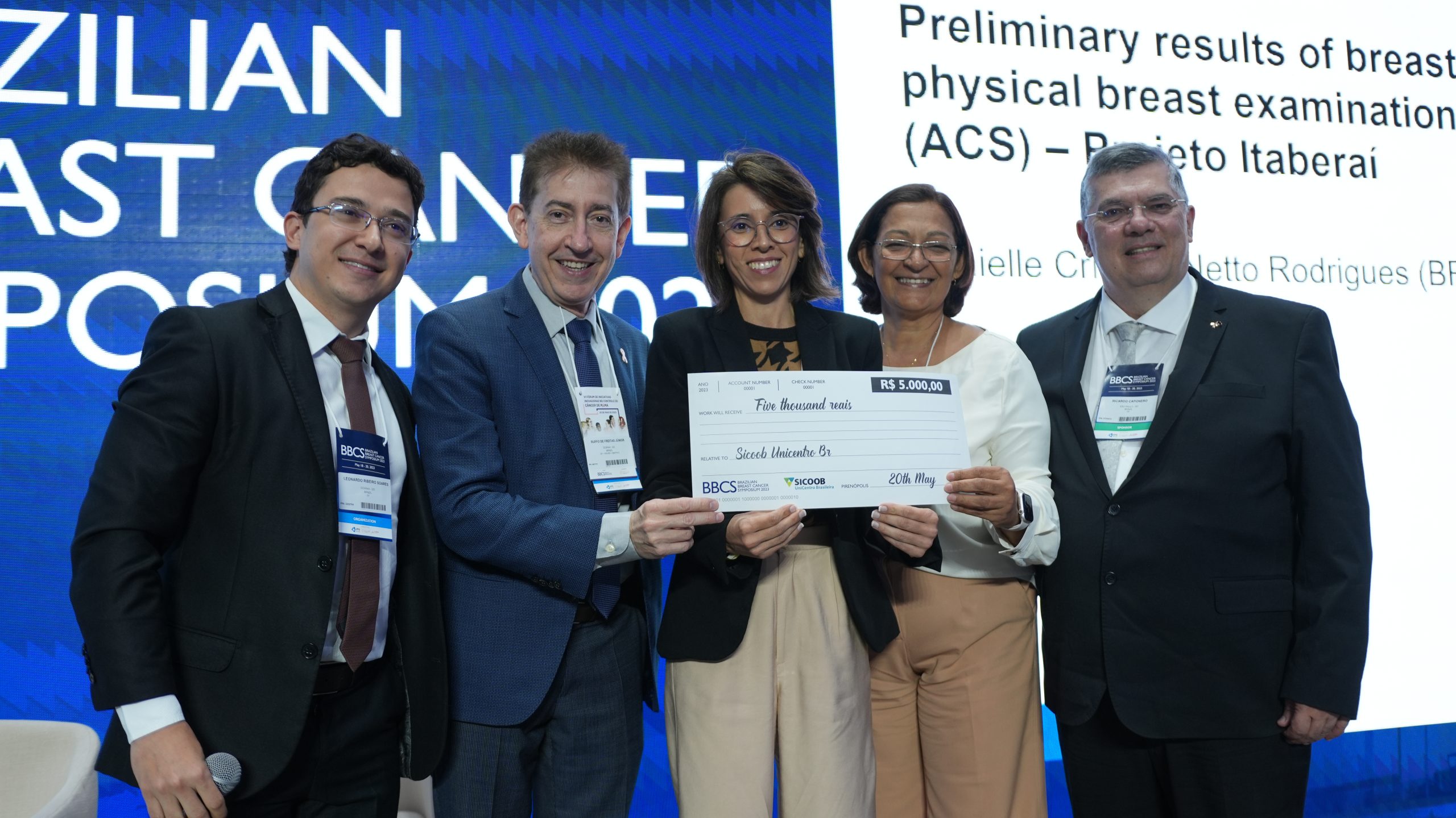
An award honoring the official financial Institution of the event – Sicoob. At first, this prize was granted to the best study conducted in the states of Goiás, Tocantins or the Federal District (or when the author was originally from one of these states). Today, the award is given to the best research work carried out in Brazil, the author being at most 45 years old at the day of the paper submission.

PRELIMINARY RESULTS OF BREAST CANCER SCREENING BASED ON PHYSICAL BREAST EXAMINATION BY COMMUNITY HEALTH AGENT (ACS) – PROJETO ITABERAÍ.
Danielle Cristina Netto Rodrigues¹, Rosangela da Silveira Correa¹, Christina Souto Cavalcante Costa¹, Paola Ferreira de Freitas¹, Nicaella Eterna de Oliveira Santos¹, Maria do Carmo Egito de Sá², Douglas Euclides da Silva², Ruffo Freitas-Júnior¹
¹ CORA – Advanced Breast Diagnosis Center, Federal University of Goias. Brazilian Breast Cancer Research Network|Goiania|Goias|Brazil
² Municipal Secretary of Health of Itaberaí, Goiás|Itaberaí|Goias|Brazil
Objective: Introduction: the ITABERAÍ Project is a study that deals with Intervention through Training of Community Health Agents (ACS) Based on Evidence of Tracking in Physical Examination of the Breast. Objective: to present preliminary results of breast cancer screening carried out by Community Health Agents (ACS) in women aged 40 years or older, according to the ITABERAÍ Project. Methodology: Methodology: Phase III multicenter randomized clinical trial, whose observation unit was data from women aged 40 years or older, without a diagnosis of breast cancer, who consented to participate in the study and were registered by the ACS in the Pink Application. For randomization, the Family Health Team (ESF) of each ACS was considered and these were randomly allocated into Control Group and Intervention Group. The physical examination of the breast performed by the ACS was considered as an Intervention. Results: Results: Until now, 1261 women have participated in the study, 1259 (64.2%) from the CG and 702 (35.8%) from the IG. The mean age was 56.8, in the CG it was 56.7 years ±11.22 and in the GI it was 57.1 years ±11.18 (p=0.47). Of the total number of women, 85.5% reported not having health insurance, 78.5% seek medical assistance annually, 73% do not perform physical activity, 88.4% declared not to be a smoker, 92.7% did not use alcohol, 65% had a high IMC and 75.7% reported having had a mammogram at some point in their lives. There was no significant difference in these variables between groups. A total of 174 (24.8%) altered cases were identified in the physical examinations performed by the ACS, and of these, 2 (1.1%) cases with diagnostic confirmation of breast cancer after biopsy. Conclusion: Conclusion: Preliminary results show that trained Community Health Agents can support breast cancer screening and generate information that can support decision-making and optimize public spending on health.
Keywords: Screening, Breast Cancer, Community Health Workers
VALIDATION OF A NOVEL IN VITRO BREAST CANCER CHEMORESISTANCE PLATFORM IN NEOADJUVANT SETTING
Martina Lichtenfels1, Camila Alves da Silva1, Alessandra Borba Anton de Souza2, Heloisa Rezende3, Luiza Kobe2, Isabela Miranda2, Antônio Luiz Frasson 2,4, Caroline Brunetto de Farias1
1Ziel Biosciences, Porto Alegre (RS) – Brazil
2Centro de Mama PUCRS, Porto Alegre (RS) – Brazil
3Hospital HINJA, Volta Redonda (RJ) – Brazil
4Hospital Israelita Albert Einstein, São Paulo (SP) – Brazil
Objective: The aim of our study is to validate a novel in vitro chemoresistance platform for two drugs commonly used in the neoadjuvant setting for breast cancer (BC).
Methodology: Three BC cell lines (MCF-7 (luminal); SKBR3 (HER2+); MDA-MB-231 (triple negative)) were used to confirm the efficacy of the platform. Patients with invasive BC and partial response to neoadjuvant chemotherapy were included in this initial report. Fresh tumor samples were collected during surgery and dissociated to obtaining the tumor cells. The tumor cells were cultured in the chemoresistance platform with doxorubicin and paclitaxel and after 72h cell viability was evaluated. The test result is defined based on cell viability as low (< 40%), medium (40-60%) and high (> 60%) resistance.
Results: The three BC cell lines presented low resistance to doxorubicin, MCF-7 and SKBR3 cells also presented low resistance to paclitaxel whereas MDA-MB-231 has intermediate resistance. Samples from 10 BC patients with partial response to neoadjuvant chemotherapy were tested in the novel chemoresistance platform. All the patients received doxorubicin and paclitaxel as part of the treatment. The overall rate of assay success was 100%. Regarding molecular subtypes, 40% were Luminal, 20% LuminalHER2, 10% HER2, and 30% triple negative. The 10 samples presented 100% of high resistance to paclitaxel. High resistance to doxorubicin was observed in 70% of the samples, intermediate in 10% and low in 20%. The chemoresistance platform demonstrated that samples already treated with paclitaxel and doxorubicin in neoadjuvant setting presented more high resistance to the drugs compared to the BC cell lines.
Conclusion: This preliminary result demonstrated more high resistance in tumors previously treated with doxorubicin and paclitaxel compared to BC cell lines without previous treatment and highlighted the success of the in vitro chemoresistance platform to test tumor samples after neoadjuvant treatment.
Keywords: Breast neoplasms; neoadjuvant therapy; Neoplasm drug resistance